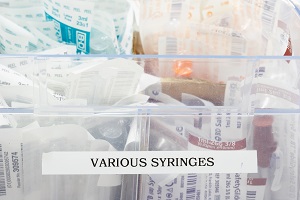Trypanophobia
 Trypanophobia is the fear of needles, blood draws, or injections, and is often simply called needle phobia.
Trypanophobia is the fear of needles, blood draws, or injections, and is often simply called needle phobia.
What Is Trypanophobia?
Few people enjoy getting injections or having their blood drawn, but needle phobia is far more than just a little anxiety or fear of pain. People with needle phobia are terrified of needles and may even put their own lives in danger to avoid an injection. Needle phobia can provoke a physical reaction that causes a person’s blood pressure to drop rapidly, and a few people have died from this reaction. Consequently, medical practitioners need to be particularly careful when treating people who have needle phobia.
Symptoms of needle phobia include:
- Panic, fainting, or hyperventilating around needles
- Fear of doctors
- Fear of watching other people get an injection
- Fear of blood or veins
- Avoiding procedures that involve a needle
What Causes Trypanophobia?
Sometimes a needle phobia has no cause, and some doctors have speculated that the fear of sharp objects could have an evolutionary origin. Needle phobia tends to run in families, and children of needle phobic parents are more likely to develop the phobia themselves. Traumatic experiences with needles, such as being restrained or mistreated by a doctor, can contribute to the development of needle phobia. Some people with the phobia may have unusual pain sensitivity and fear the pain more than the needle itself.
How Is Trypanophobia Treated?
A number of techniques can be used to treat needle phobia, and sensitive medical practitioners who are willing to take their time and understand the diagnosis can make injections and blood draws less traumatic. Hypnosis and behavioral therapy can be particularly effective, and some people with needle phobia benefit from numbing creams and other techniques designed to deaden the sensations associated with an injection or blood draw.
Reference:
- Hart, P. S., & Yanny, W. (1998). Needle phobia and malignant vasovagal syndrome. Anaesthesia, 53(10), 1002-1004. doi: 10.1046/j.1365-2044.1998.00570.x
Last Updated: 01-17-2018